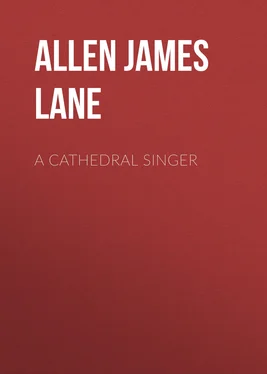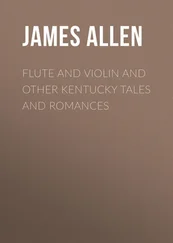James Allen - A Cathedral Singer
Здесь есть возможность читать онлайн «James Allen - A Cathedral Singer» — ознакомительный отрывок электронной книги совершенно бесплатно, а после прочтения отрывка купить полную версию. В некоторых случаях можно слушать аудио, скачать через торрент в формате fb2 и присутствует краткое содержание. Жанр: foreign_prose, foreign_antique, на английском языке. Описание произведения, (предисловие) а так же отзывы посетителей доступны на портале библиотеки ЛибКат.
- Название:A Cathedral Singer
- Автор:
- Жанр:
- Год:неизвестен
- ISBN:нет данных
- Рейтинг книги:4 / 5. Голосов: 1
-
Избранное:Добавить в избранное
- Отзывы:
-
Ваша оценка:
- 80
- 1
- 2
- 3
- 4
- 5
A Cathedral Singer: краткое содержание, описание и аннотация
Предлагаем к чтению аннотацию, описание, краткое содержание или предисловие (зависит от того, что написал сам автор книги «A Cathedral Singer»). Если вы не нашли необходимую информацию о книге — напишите в комментариях, мы постараемся отыскать её.
A Cathedral Singer — читать онлайн ознакомительный отрывок
Ниже представлен текст книги, разбитый по страницам. Система сохранения места последней прочитанной страницы, позволяет с удобством читать онлайн бесплатно книгу «A Cathedral Singer», без необходимости каждый раз заново искать на чём Вы остановились. Поставьте закладку, и сможете в любой момент перейти на страницу, на которой закончили чтение.
Интервал:
Закладка:
James Lane Allen
A Cathedral Singer
I
Slowly on Morningside Heights rises the Cathedral of St. John the Divine: standing on a high rock under the Northern sky above the long wash of the untroubled sea, above the wash of the troubled waves of men.
It has fit neighbors. Across the street to the north looms the many-towered gray-walled Hospital of St. Luke—cathedral of our ruins, of our sufferings and our dust, near the cathedral of our souls.
Across the block to the south is situated a shed-like two-story building with dormer-windows and a crumpled three-sided roof, the studios of the National Academy of Design; and under that low brittle skylight youth toils over the shapes and colors of the visible vanishing paradise of the earth in the shadow of the cathedral which promises an unseen, an eternal one.
At the rear of the cathedral, across the roadway, stands a low stone wall. Just over the wall the earth sinks like a precipice to a green valley bottom far below. Out here is a rugged slope of rock and verdure and forest growth which brings into the city an ancient presence, nature—nature, the Elysian Fields of the art school, the potter's field of the hospital, the harvest field of the church.
This strip of nature fronts the dawn and is called Morningside Park. Past the foot of it a thoroughfare stretches northward and southward, level and wide and smooth. Over this thoroughfare the two opposite-moving streams of the city's traffic and travel rush headlong. Beyond the thoroughfare an embankment of houses shoves its mass before the eyes, and beyond the embankment the city spreads out over flats where human beings are as thick as river reeds.
Thus within small compass humanity is here: the cathedral, the hospital, the art school, and a strip of nature, and a broad highway along which, with their hearth-fires flickering fitfully under their tents of stone, are encamped life's restless, light-hearted, heavy-hearted Gipsies.
It was Monday morning and it was nine o'clock. Over at the National Academy of Design, in an upper room, the members of one of the women's portrait classes were assembled, ready to begin work. Easels had been drawn into position; a clear light from the blue sky of the last of April fell through the opened roof upon new canvases fastened to the frames. And it poured down bountifully upon intelligent young faces. The scene was a beautiful one, and it was complete except in one particular: the teacher of the class was missing—the teacher and a model.
Minutes passed without his coming, and when at last he did enter the room, he advanced two or three steps and paused as though he meant presently to go out again. After his usual quiet good-morning with his sober smile, he gave his alert listeners the clue to an unusual situation:
"I told the class that to-day we should begin a fresh study. I had not myself decided what this should be. Several models were in reserve, any one of whom could have been used to advantage at this closing stage of the year's course. Then the unexpected happened: on Saturday a stranger, a woman, came to see me and asked to be engaged. It is this model that I have been waiting for down-stairs."
Their thoughts instantly passed to the model: his impressive manner, his respectful words, invested her with mystery, with fascination. His countenance lighted up with wonderful interest as he went on:
"She is not a professional; she has never posed. In asking me to engage her she proffered barely the explanation which she seemed to feel due herself. I turn this explanation over to you because she wished, I think, that you also should not misunderstand her. It is the fee, then, that is needed, the model's wage; she has felt the common lash of the poor. Plainly here is some one who has stepped down from her place in life, who has descended far below her inclinations, to raise a small sum of money. Why she does so is of course her own sacred and delicate affair. But the spirit in which she does this becomes our affair, because it becomes a matter of expression with her. This self-sacrifice, this ordeal which she voluntarily undergoes to gain her end, shows in her face; and if while she poses, you should be fortunate enough to see this look along with other fine things, great things, it will be your aim to transfer them all to your canvases—if you can."
He smiled at them with a kind of fostering challenge to their over-confident impulses and immature art. But he had not yet fully brought out what he had in mind about the mysterious stranger and he continued:
"We teachers of art schools in engaging models have to take from human material as we find it. The best we find is seldom or never what we would prefer. If I, for instance, could have my choice, my students would never be allowed to work from a model who repelled the student or left the student indifferent. No students of mine, if I could have my way, should ever paint from a model that failed to call forth the finest feelings. Otherwise, how can your best emotions have full play in your work; and unless your best emotions enter into your work, what will your work be worth? For if you have never before understood the truth, try to realize it now: that you will succeed in painting only through the best that is in you; just as only the best in you will ever carry you triumphantly to the end of any practical human road that is worth the travel; just as you will reach all life's best goals only through your best. And in painting remember that the best is never in the eye, for the eye can only perceive, the eye can only direct; and the best is never in the hand, for the hand can only measure, the hand can only move. In painting the best comes from emotion. A human being may lack eyes and be none the poorer in character; a human being may lack hands and be none the poorer in character; but whenever in life a person lacks any great emotion, that person is the poorer in everything. And so in painting you can fail after the eye has gained all necessary knowledge, you can fail after your hand has received all necessary training, either because nature has denied you the foundations of great feeling, or because, having these foundations, you have failed to make them the foundations of your work.
"But among a hundred models there might not be one to arouse such emotion. Actually in the world, among the thousands of people we know, how few stir in us our best, force us to our best! It is the rarest experience of our lifetimes that we meet a man or a woman who literally drives us to the realization of what we really are and can really do when we do our best. What we all most need in our careers is the one who can liberate within us that lifelong prisoner whose doom it is to remain a captive until another sets it free—our best. For we can never set our best free by our own hands; that must always be done by another."
They were listening to him with a startled recognition of their inmost selves. He went on to drive home his point about the stranger:
"I am going to introduce to you, then, a model who beyond all the others you have worked with will liberate in you your finer selves. It is a rare opportunity. Do not thank me. I did not find her. Life's storms have blown her violently against the walls of the art school; we must see to it at least that she be not further bruised while it becomes her shelter, her refuge. Who she is, what her life has been, where she comes from, how she happens to arrive here—these are privacies into which of course we do not intrude. Immediately behind herself she drops a curtain of silence which shuts away every such sign of her past. But there are other signs of that past which she cannot hide and which it is our privilege, our duty, the province of our art, to read. They are written on her face, on her hands, on her bearing; they are written all over her—the bruises of life's rudenesses, the lingering shadows of dark days, the unwounded pride once and the wounded pride now, the unconquerable will, a soaring spirit whose wings were meant for the upper air but which are broken and beat the dust. All these are sublime things to paint in any human countenance; they are the footprints of destiny on our faces. The greatest masters of the brush that the world has ever known could not have asked for anything greater. When you behold her, perhaps some of you may think of certain brief but eternal words of Pascal: 'Man is a reed that bends but does not break.' Such is your model, then, a woman with a great countenance; the fighting face of a woman at peace. Now out upon the darkened battle-field of this woman's face shines one serene sun, and it is that sun that brings out upon it its marvelous human radiance, its supreme expression: the love of the mother. Your model is the beauty of motherhood, the sacredness of motherhood, the glory of motherhood: that is to be the portrait of her that you are to paint."
Читать дальшеИнтервал:
Закладка:
Похожие книги на «A Cathedral Singer»
Представляем Вашему вниманию похожие книги на «A Cathedral Singer» списком для выбора. Мы отобрали схожую по названию и смыслу литературу в надежде предоставить читателям больше вариантов отыскать новые, интересные, ещё непрочитанные произведения.
Обсуждение, отзывы о книге «A Cathedral Singer» и просто собственные мнения читателей. Оставьте ваши комментарии, напишите, что Вы думаете о произведении, его смысле или главных героях. Укажите что конкретно понравилось, а что нет, и почему Вы так считаете.












